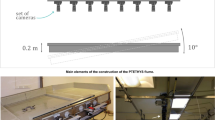Abstract
Beaver dams on small rivers significantly alter their hydrological regime. Formation of maximum break discharges on small rivers and flooding of areas are one of the detrimental consequences caused by the failure of such dams. Based on our survey of 11 dams and ponds in the Vereshchaginskii district (Perm oblast), as well as on cartographic modeling of 20 ponds, the dependences of the pond basin volume on the length of the pond and the maximum height of the dam have been established, which can be used to estimate the approximate volume of these ponds. When the dam height changes from 0.5 to 3.4 m and its length changes from 5 to 50 m, the volume of the pond basin alters from 0 to 850 m3. According to the results of artificial dam failure, the following aspects have been established: the nature of simulated flood propagation, the dependence of hydrological characteristics on stages; runoff hydrographs and volumes, as well as the nature of the drained pond bed. It has also been found that the development of the closure channel in the body of dams is unlikely to take place and that erosion mainly occurs on riverbank soils. Based on calculations, it has been revealed that the quantities of natural full-scale break discharges are equal to the maximum rain flood discharge with a 10% probability of exceedance. Full-scale break discharges differ from those calculated according to the hydraulics formulas by 10 to 30%. The maximum discharge values during our experiment ranged from 50 to 500 L/s; the amount of time to empty the ponds varied from 100 to 180 min.
Similar content being viewed by others
References
Andersen, D.C. and Shafroth, P.B., Beaver dams, hydrological thresholds, and controlled floods as a management tool in a desert riverine ecosystem, Bill Williams River, Arizona, Ecohydrology, 2010, Vol. 3, No. 3, pp. 325–338.
Baker, B.W. and Hill, E.P., Beaver (Castor canadensis), in Wild Mammals of North America: Biology, Management, and Conservation, Feldhamer, G.A., Thompson, B.C., and Chapman, J.A., Eds., Baltimore: Johns Hopkins Univ. Press, 2003, pp. 288–310.
Burn, D.A. and McDonnell, J.J., Effects of beaver pond on runoff processes: comparison of two headwater catchment, J. Hydrol., 1998, Vol. 205, pp. 348–264.
Butler, D.R., The failure of beaver dams and resulting outburst flooding: a geomorphic hazard of the southeastern Piedmont, Geogr. Bull., 1989, Vol. 31, pp. 29–38.
Butler, D.R. and Malanson, G.P., Sedimentation rates and patterns in beaver ponds in a mountain environment, Geomorphology, 1995, Vol. 13, pp. 255–269.
Butler, D.R. and Malanson, G.P., The geomorphic influence of beaver dams and failures of beaver dams, Geomorphology, 2005, Vol. 71, pp. 48–60.
Eponchintseva, D.N. and Klimenko, D.E., Assessing the effect of beaver dams on the exploitation of culverts under highway embankments, Inzhenern. Izysk., 2013, No. 3, pp. 68–72.
Hartman, G. and Törnlöv, S., Influence of watercourse depth and width on damming behavior by Eurasian beaver (Castor fiber), J. Zool., 2006, Vol. 268, pp. 127–131.
Luchsheva, A.A., Prakticheskaya gidrometriya: ucheb. posobie dlya vuzov po spets. “Gidrologiya sushi” (Practical Hydrometry: A Manual for Students in Land Hydrology), 2nd ed., Leningrad: Gidrometeoizdat, 1983.
Metodicheskie rekomendatsii po opredeleniyu raskhodov vody pri proektirovanii perekhodov cherez vodotoki v zone vozdeistviya nekapital’nykh plotin (Methodological Guidelines for Determining Water Flow Rates in Designing Road Passages over Streams in Zones Affected by Temporary Dams), Moscow: TsNIIS Mintransstroya SSSR, 1981.
Nolet, B.A., Reintroduction of beaver in the Rhine and Meuse estuary, in Semiaquatische Saugetiere: 2 Internationalien Symposiums, Schropfer, R., Stubbe, M., and Heidecke, D., Eds., Halle: Univ. of Halle Press, 1992, pp. 130–140.
Resursy poverkhnostnykh vod SSSR (Land Surface Water Resources in the Soviet Union), vol. 11: Srednii Ural i Priural’e (The Middle Urals and Transural Region), Leningrad: Gidrometeoizdat, 1973.
Savichev, E.A., Mnogoobrazie i struktura poselenii na vodotokakh zapovednika “Visherskii” (Diversity and Structure of Beaver Settlements on Streams of the Visherskii Nature Reserve), Perm: Perm. Gos. Univ., 2010a.
Savichev, E.A., Rezul’taty inventarizatsii poselenii bobra (Castor fiber) v zapovednike “Visherskii” (The Results of Inventory of Beaver (Castor fiber) colonies in the Visherskii Nature Reserve), Perm: Perm. Gos. Univ., 2010b.
Svod pravil po proektirovaniyu i stroitel’stvu. Opredelenie osnovnykh raschetnykh gidrologicheskikh kharakteristik. SP 33-101-2003 (Design and Construction Rules and Regulations SP 33-101-2003: Calculation of Basic Hydrological Caharacteristics), Moscow: Stroiizdat, 2004.
Woo, M.K. and Waddington, J.M., Effects of beaver dams on subarctic wetland hydrology, Arctic, 1990, Vol. 43, No. 3, pp. 223–230.
Wright, J.P., Gurney, W.S.C., and Jones, C.G., Patch dynamics in a landscape modified by ecosystem engineers, Oikos, 2004, Vol. 105, No. 2, pp. 336–348.
Zahner, V., Dam building by beaver (Castor fiber) and its impact on forest stands in South Germany, in Proc. of the First Euro-American Beaver Congress, Kazan, 2001, pp. 119–126.
Author information
Authors and Affiliations
Corresponding author
Additional information
Original Russian Text © D.E. Klimenko, D.N. Eponchintseva, 2014, published in Povolzhskii Ekologicheskii Zhurnal, 2014, No. 3, pp. 351–363.
Rights and permissions
About this article
Cite this article
Klimenko, D.E., Eponchintseva, D.N. Experimental hydrological studies of processes of failure of beaver dams and pond draining. Biol Bull Russ Acad Sci 42, 882–890 (2015). https://doi.org/10.1134/S1062359015100064
Received:
Published:
Issue Date:
DOI: https://doi.org/10.1134/S1062359015100064




